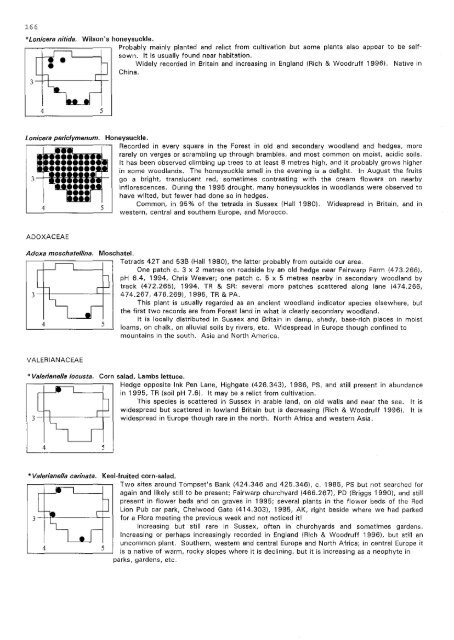Flora of Ashdown Forest - Botanical Society of the British Isles
Flora of Ashdown Forest - Botanical Society of the British Isles
Flora of Ashdown Forest - Botanical Society of the British Isles
You also want an ePaper? Increase the reach of your titles
YUMPU automatically turns print PDFs into web optimized ePapers that Google loves.
166* Lonicera nitida. Wilson' 5 honeysuckle.Probably mainly planted and rel'let from cultivation but some plants also appear to be selfsown,It is usually found near habitation .•Widely recorded in Britain and increasing in England (Rich & Woodruff 1996). Native inChina.3 -++------'-+-4 5Lonicera periclymenum. Honeysuckle.Recorded in every square in <strong>the</strong> <strong>Forest</strong> in old and secondary woodland and hedges, morerarely on verges or scrambling up through brambles, and most common on moist, acidic soils.It has been observed climbing up trees to at least 8 metres high, and it probably grows higherin some woodlands. The honeysuckle smell in <strong>the</strong> evening is a delight. In August <strong>the</strong> fruitsgo a bright, translucent red, sometimes contrasting with <strong>the</strong> cream flowers on nearbyinflorescences. During <strong>the</strong> 1995 drought, many honeysuckles in woodlands were observed tohave wilted, but fewer had done so in hedges.Common, in 95% <strong>of</strong> <strong>the</strong> tetrads in Sussex (Hall 1980). Widespread in Britain, and inwestern, central and sou<strong>the</strong>rn Europe, and Morocco.AOOXACEAEAdoxa moschatellina. Moschatel.Tetrads 42T and 53B (Hall 1980), <strong>the</strong> latter probably from outside our area.One patch c. 3 x 2 metres on roadside by an old hedge near Fairwarp Farm (473.266LpH 6.4, 1994, Chris Weaver; one patch c. 5 x 5 metres nearby in secondary woodland bytrack (472.265), 1994, TR & SR; several more patches scattered along lane (474.266,3 474.267,476.269), 1995, TR & PA.This plant is usually regarded as an ancient woodland indicator species elsewhere, but<strong>the</strong> first two records are from <strong>Forest</strong> land in what is clearly secondary woodland.45It is locally distributed in Sussex and Britain in damp, shady, base-rich places in moistloams, on chalk, on alluvial soils by rivers, etc. Widespread in Europe though confined tomountains in <strong>the</strong> south. Asia and North America.VALERIANACEAE* Valerianella locusta. Corn salad, Lambs lettuce.r--.,----===----,--, Hedge opposite Ink Pen Lane, Highgate (426.343), 1986, PS, and still present in abundancein 1995, TR (soil pH 7.6). It may be a relict from cultivation.This species is scattered in Sussex in arable land, on old walls and near <strong>the</strong> sea. It iswidespread but scattered in lowland Britain but is decreasing (Rich & Woodruff 1996). It iswidespread in Europe though rare in <strong>the</strong> north. North Africa and western Asia.3 -++------'--+-4 5* Valerianella carinata. Keel~fruited corn~salad.Two sites around Tompset's Bank (424.346 and 425.346), c. 1985, PS but not searched foragain and likely still to be present; Fairwarp churchyard (466.2671, PO (Briggs 1990), and stillpresent in flower beds and on graves in 1995; several plants in <strong>the</strong> flower beds <strong>of</strong> <strong>the</strong> RedLion Pub car park, Chelwood Gate (414.303), 1995, AK, right beside where we had parked3 -+-I'"------'-+_ for a <strong>Flora</strong> meeting <strong>the</strong> previous week and not noticed it!Increasing but still rare in Sussex, <strong>of</strong>ten in churchyards and sometimes gardens.4 5Increasing or perhaps increasingly recorded in England (Rich & Woodruff 1996), but still anuncommon plant. Sou<strong>the</strong>rn, western and central Europe and North Africa; in central Europe itis a native <strong>of</strong> warm, rocky slopes where it is declining, but it is increasing as a neophyte inparks, gardens, etc.
















